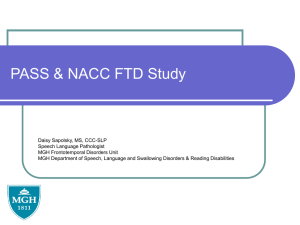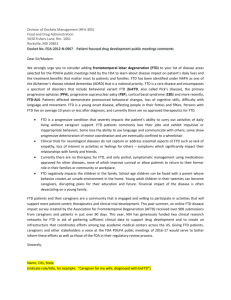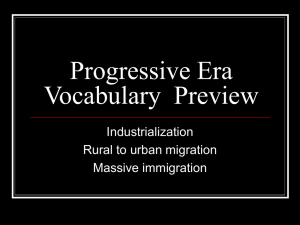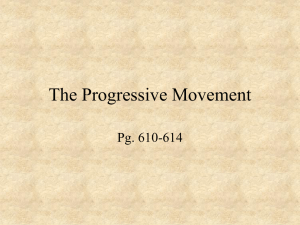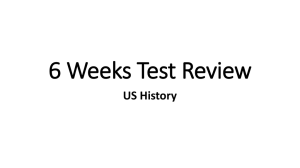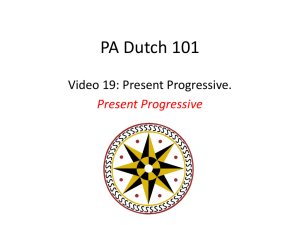MapThruMaze_2011_sapolsky
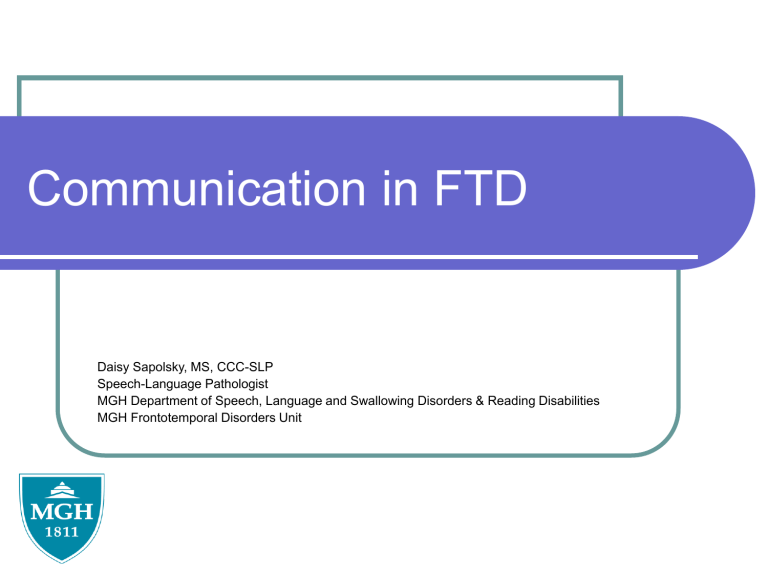
Communication in FTD
Daisy Sapolsky, MS, CCC-SLP
Speech-Language Pathologist
MGH Department of Speech, Language and Swallowing Disorders & Reading Disabilities
MGH Frontotemporal Disorders Unit
Topics
Subtypes of FTD
Communication challenges
Compensatory strategies
MGH FTD Unit and Progressive
Communication Disorders Program
Terms
Aphasia
An acquired communication disorder that impairs a person's ability to process language, but does not affect intelligence .
Can have impairment in one or more areas:
speaking
understanding others
reading
writing/spelling http://www.aphasia.org/
Terms
Primary Progressive Aphasia (Mesulam, 1982)
A language disorder (“aphasia”) that worsens over time (“progressive”), and is the most prominent problem the person experiences (“primary”)
Subtypes of FTD
Frontotemporal Dementia (FTD)
Primary Progressive Aphasia (PPA) Behavioral Variant (bvFTD)
Progressive Nonfluent Aphasia (PNFA)
Semantic Dementia (SD)
Logopenic Progressive Aphasia (LPA)
Progressive nonfluent aphasia (PNFA)
agrammatism nonfluent speech, may be telegraphic
hesitant, effortful, pauses, hesitations, fillers (e.g., umm)
difficulty with verbs and functor words (e.g., the, for, an, to)
knowing what you want to say, but can’t think of the word or can’t get the word out
comprehension is (typically) intact
there may be difficulty in comprehension of complex syntactic forms
Progressive nonfluent aphasia (PNFA)
impaired reading and writing
difficulty with forming grammatically correct sentences
difficulty with reading complex sentences; comprehension of single words usually intact
or, writing may be significantly better than speech in some patients
spelling difficulty
yes/no confusion
pronoun confusion
Progressive nonfluent aphasia (PNFA)
picture description:
“Umm, you know, the umm, the family for uh the picnic...umm...maybe the Cape...you know, the umm, like sailing and fishing and umm the ah, uh, girl is umm, the umm, the sandcastles, and umm the picnic man’s reading a book and umm the lady is uh, wine, and you know, like summertime, summertime.”
Picnic scene picture
Western Aphasia Battery-Revised (Kertesz, A., 2007)
Subtypes of FTD
Frontotemporal Dementia (FTD)
Primary Progressive Aphasia (PPA) Behavioral Variant (Beh)
Progressive Nonfluent Aphasia (PNFA)
Semantic Dementia (SD)
Logopenic Progressive Aphasia (LPA)
Semantic dementia (SD)
loss of knowledge of the meanings of words
lower frequency/uncommon words most affected
“What is a ___?”
use of vague/general words (e.g., stuff, thing)
speech content has an empty quality
lack of detail, common/vague words
but, speech is fluent and grammatical
Semantic dementia (SD)
picture description:
“There’s a guy and a dog and this, and then there’s a girl and another dog, and something. And, they’re eating. This is the...I should know that because I always do it...I always know that usually.”
Subtypes of FTD
Frontotemporal Dementia (FTD)
Primary Progressive Aphasia (PPA) Behavioral Variant (bvFTD)
Progressive Nonfluent Aphasia (PNFA)
Semantic Dementia (SD)
Logopenic Progressive Aphasia (LPA)
Logopenic Progressive Aphasia (LPA)
intermittent word-finding hesitations
impaired naming
phonemic paraphasias (saying words or nonwords that share some sounds with the correct word)
“octible” for octopus
“rackel” for racquet
“glow” for globe
Logopenic Progressive Aphasia (LPA)
picture description:
It looks like a family is, has a hou , uh, I think it’s a house or a friend’s place, on the leck lake...Uh, and uh, there’s somebody who’s uh finishing, uh, fishing ...Uh some friends are in the boat, in the so, sailboat, sail, sailboat ...They uh, the mother is putting some, I’d like to think it’s wing uh wine ...
Subtypes of FTD
Frontotemporal Dementia (FTD)
Primary Progressive Aphasia (PPA) Behavioral Variant (bvFTD)
Progressive Nonfluent Aphasia (PNFA)
Semantic Dementia (SD)
Logopenic Progressive Aphasia (LPA)
Behavioral variant FTD (bvFTD)
As patients may do well in testing, they are often not thought to have a primary speech/language disorder.
However, the hallmark changes in behavior and personality directly affect daily communication and functioning, and therefore can result in a communication disorder.
Behavioral variant FTD (bvFTD)
apathetic variant
flat affect, emotional blunting
not expressing emotion, not understanding or reading someone else’s emotion
withdrawal, loss of interest (apathy)
not engaging in conversation or previously enjoyed activities
lack of initiation
only speaks when spoken to
Behavioral variant FTD (bvFTD)
disinhibited variant
saying inappropriate things or in an inappropriate way
inappropriate increase in talking
press of speech
not reading social cues that someone is not interested in the conversation or is ready to stop the conversation
compulsive behaviors
Topics
Subtypes of FTD
Communication challenges
Compensatory strategies
MGH FTD Unit and Progressive
Communication Disorders Program
Common communication challenges
knowing what you want to say but the words won’t come out → frustration
able to express basic wants and needs, but difficulty with higher-level conversation
“I miss the discourse.”
feeling rushed and pressured to get your thoughts out
may result in withdrawing from social situations one patient said she doesn’t want to make people wait for her to come up with words
Common communication challenges
communicating the problem to friends and family, people at work
carrying out routines and activities
difficulty reading and writing may mean the loss of previously enjoyed and practical activities
adjusting to new communication style
“I used to be a fast talker.”
Topics
Subtypes of FTD
Communication challenges
Compensatory strategies
MGH FTD Unit and Progressive
Communication Disorders Program
Example compensatory strategies
key words and semantic cueing
patient provides key words instead of attempting to say full sentences
patient describes the concept/word using semantic features
5 w’s template
helps patient organize thoughts visual guide
multiple-choice questions
partner asks multiple-choice or yes/no questions
Example compensatory strategies
visual materials
use a newspaper headline, photo, or other visual material as conversation topic
elaboration
help patient elaborate on previous response
gesture (e.g., past, future, yes/no, size, shape)
Example compensatory strategies
prewritten “scripts”
write brief scripts to be used in specific situations
practicing may reduce the pressure of the moment
can be used to read from or to show to the partner
Please pump $20 worth of gas.
How was your vacation to Paris?
I need to find a dress to wear to a wedding.
I need to return these shoes because they didn’t fit.
Example compensatory strategies
communication book
primary or supplementary communication
update topics/formats as needed
point to pictures/words:
people (family members, friends)
places (shops, restaurants)
food
activities
emotions
time/date
Example compensatory strategies
slow down – both patient and partner
patient has more time to think of words and organize thoughts
allows patient time to process what is being said to him/her
relieves the pressure of a fast-paced conversation
Example compensatory strategies
Identify barriers to functioning in the home or workplace and be creative in brainstorming solutions
e.g., a patient with non-fluent speech allows calls to go to voicemail, enabling her to take time to formulate a response, write a script, or send an email response
Example compensatory strategies
Identify activities, hobbies, and volunteer opportunities that have low demand on language (arts, music, gardening).
Discuss when a job or responsibility is no longer manageable. Create an action plan to leave the situation.
Example compensatory strategies
Prompt the patient to use any means of expression
gesturing, writing, drawing, pointing to pictures or words, facial expression
Refer to an AAC (Augmentative & Alternative
Communication) center
For apraxia of speech, try traditional motor speech strategies
Example compensatory strategies
Some patients have reported success!
From an e-mail:
Script for a phone conversation for friends, a business, and doctors - I practice the script until I can speak decently.
Gestures, facial expression, and body language...two-thumbs-up, wave, and five high slap...and dance around with my body.
Syllable attack is very helpful. I break down the long word into syllables and practice them slowly. Then I quicken my speed until
I can pronounce the word properly...
They (strategies) are helpful. It takes a long time to practice a script on the phone but it pays off. The reward is speaking more normally...not perfect!
Strategies: Behavioral variant
Set up situations and routines that allow the patient to respond to others, instead of needing to initiate communication themselves
Brainstorm ways to engage the patient in activities and communication
Strategies: Behavioral variant
Break down tasks into manageable steps that are not overwhelming (e.g., setting the table)
daily calendar/schedule to provide a list of activities and to-do items
do this together so that the patient has input
phone message template
Topics
Subtypes of FTD
Communication challenges
Compensatory strategies
MGH FTD Unit and Progressive
Communication Disorders Program
MGH Progressive Communication
Disorders Program
goals of the evaluation:
identify strengths and weaknesses in speech/language abilities, compensations already in use, communication partners, and what is/isn’t working in daily life develop functional goals:
to maintain and enhance communication; and to prepare for future decline
goals of the therapy program:
teach/practice compensatory strategies to facilitate communication in everyday situations educate the patient/partner about the diagnosis and implications for communication brainstorm suggestions for modifying the environment to facilitate communication troubleshoot barriers to communication and participation provide check-ins and ongoing support
program structure:
individual sessions that vary in frequency and duration for patient and partner
“tune-up” sessions to review strategies and determine if another round of therapy is warranted group therapy to practice strategies within a comfortable setting and to meet others
